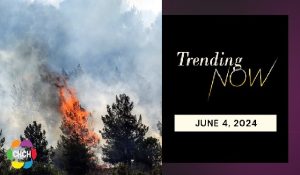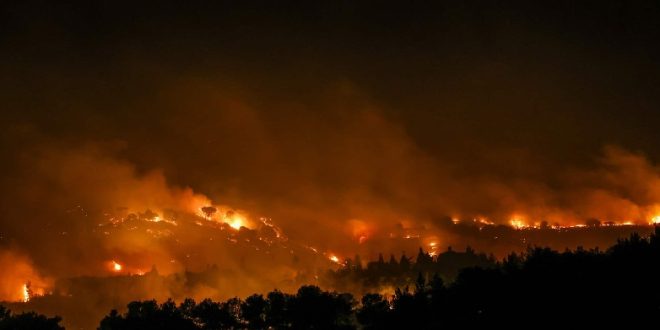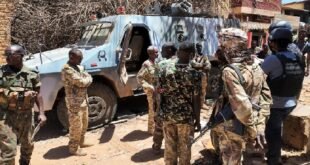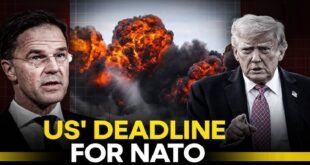06-06-2024
JERUSALEM: Firefighters battled raging blazes across northern Israel on June 3-4, ignited by rocket barrages launched by Hezbollah terrorists across the border in Lebanon. “Some 15 active fire sites were reported in the  Galilee-Golan region alone, most resulting from rocket fire on an exceptionally hot day, with temperatures exceeding 109 degrees in Kiryat Shmona and the Sea of Galilee area,” Israel’s Ynet reported. The fires raged following several days of Hezbollah escalation in attacks on northern Israel. On June 3, fires caused by the attacks threatened the Israeli city of Kiryat Shmona, which was already evacuated of most of its residents in October 2023, following Hezbollah attacks. On June 4, a fire broke out in the Biriya forest near Safed in northern Israel. Most of the fires had been brought under control by the morning of June 4, The Times of Israel reported.
Galilee-Golan region alone, most resulting from rocket fire on an exceptionally hot day, with temperatures exceeding 109 degrees in Kiryat Shmona and the Sea of Galilee area,” Israel’s Ynet reported. The fires raged following several days of Hezbollah escalation in attacks on northern Israel. On June 3, fires caused by the attacks threatened the Israeli city of Kiryat Shmona, which was already evacuated of most of its residents in October 2023, following Hezbollah attacks. On June 4, a fire broke out in the Biriya forest near Safed in northern Israel. Most of the fires had been brought under control by the morning of June 4, The Times of Israel reported.
“Hezbollah’s decision to double its missile and drone attacks on Israel over the last month risks serious escalation. The Iranian-backed terrorist group has systematically sought to increase the range of its attacks and the sites being threatened in Israel. This has caused tens of thousands of Israelis to seek shelter in cities along the coast of northern Israel over the last two days.”
“As Hezbollah’s attacks continue to intensify, so does their destructive impact on all aspects of life in northern Israel. The wildfires caused by the group’s rocket barrages only underscore to the frontier region’s displaced residents that there is no functional life to which they can return so long as Hezbollah remains on the border.”
“Since the start of the war, Hezbollah has assessed that Israel will not widen the conflict due to other active fronts taking up military resources. However, the escalating frequency of Hezbollah’s attacks in the last few weeks, combined with the devastating fires in northern Israel triggered by the strikes, may compel Israel to take more decisive action in Lebanon.”
 Hezbollah drone and anti-tank missile attacks doubled in May, according to a report released by the Alma Research and Education Center on June 2. “In terms of analyzing the weapons used by Hezbollah, in May 2024, there was a significant increase … in the use of anti-tank missiles and UAVs, twofold compared to April 2024,” the report concluded. For instance, 95 anti-tank missiles were fired at Israel in May 2024, compared with 50 in April. “There were 85 UAV infiltration incidents in May 2024, up from 42 in April 2024,” the report added. On June 4, the Israel Defense Forces intercepted a suspicious aerial target, likely a drone, launched from Lebanon toward the Israeli city of Nahariya.
Hezbollah drone and anti-tank missile attacks doubled in May, according to a report released by the Alma Research and Education Center on June 2. “In terms of analyzing the weapons used by Hezbollah, in May 2024, there was a significant increase … in the use of anti-tank missiles and UAVs, twofold compared to April 2024,” the report concluded. For instance, 95 anti-tank missiles were fired at Israel in May 2024, compared with 50 in April. “There were 85 UAV infiltration incidents in May 2024, up from 42 in April 2024,” the report added. On June 4, the Israel Defense Forces intercepted a suspicious aerial target, likely a drone, launched from Lebanon toward the Israeli city of Nahariya.
Israel’s far-right security minister, Itamar Ben-Gvir, visiting firefighters in the nearby town of Kiryat Shmona today, said the government’s response to Hezbollah’s rockets should be war.
“No peace in Lebanon while our land is being targeted,” he said.
Herzl Halevi, Israel’s army chief of staff, also visiting the region, said the country was “approaching the point where a decision will have to be made.”
The Israel Defence Force, he said, was “prepared and ready to move to an offensive.”
Hezbollah’s deputy chief, Sheikh Naim Qassem, told media that the group was not seeking to widen the conflict with Israel but that any Israeli expansion of the war would be met “with devastation”. The government has been keen to contain this conflict on its northern border, aware that Hezbollah is a better-trained and better-equipped enemy than Hamas and that fighting here would be a very different kind of war but the fires have put this grinding forgotten conflict squarely on the front pages of national newspapers, and Israel’s Prime Minister Benjamin Netanyahu is under fresh pressure to act. (Int’l Monitoring Desk)
 Pressmediaofindia
Pressmediaofindia




